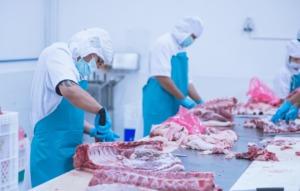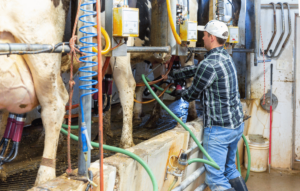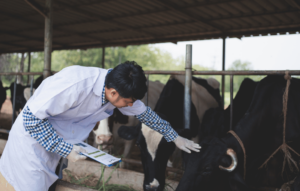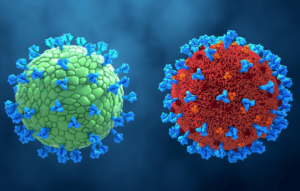The H5N1 bird flu, a highly pathogenic avian influenza virus, has recently been brought back into the media spotlight due to its spread among various animal populations, including dairy cows. While bird flu is not new, the current outbreak has raised concerns about its potential impact on both animal and human health. Understanding the environmental and health implications of this outbreak is crucial for both public awareness and preparedness.

In a recent interview, Dr. Jay Butler, deputy director for infectious diseases at the Centers for Disease Control and Prevention (CDC), provided insights into the status of the H5N1 outbreak, its risk to the public, and the measures being taken to contain its spread. This blog post aims to summarize the key points from Dr. Butler’s update, shedding light on the current situation, risk factors, and the CDC’s response efforts.
Join us as we lay out the complexities of the H5N1 bird flu outbreak, exploring its environmental and public health dimensions, and offering some practical advice to help you stay informed and protected.
Current Status of the H5N1 Outbreak
As of June 24, the H5N1 influenza virus has been detected in dairy cows on 120 premises across 12 states. This unusual spread to a new mammalian host marks a significant development in the outbreak. To date, at least three human cases have been reported in the United States, all involving individuals with direct exposure to infected cattle herds. These cases, occurring in Texas and Michigan, have thankfully been relatively mild, manifesting as conjunctivitis and mild respiratory symptoms.

Dr. Butler reassures that the current risk to the general public remains low. The lack of evidence for person-to-person transmission further supports this assessment. However, the situation demands ongoing vigilance and monitoring, as influenza viruses are known for their unpredictability. The CDC continues to keep a close eye on the outbreak, working fervently with state and local partners to manage and contain its spread.
Risk Assessment and Public Health Implications
The CDC currently assesses the risk to human health from the H5N1 influenza outbreak as low for the general public. Dr. Butler explains that this low risk is due to the limited human cases and the absence of sustained person-to-person transmission. However, certain groups are at higher risk due to their close, prolonged, or unprotected exposure to infected animals or contaminated environments. These high-risk groups include dairy workers, slaughterhouse workers, milk processing facility employees, poultry farm workers, veterinarians, and veterinary assistants.
workers, milk processing facility employees, poultry farm workers, veterinarians, and veterinary assistants.
Several factors could potentially increase the risk level to the public. If multiple simultaneous instances of animal-to-human transmission were detected, or if the virus underwent specific genetic changes, this could signal that the virus is adapting to spread more easily among people. Limited, non-sustained person-to-person transmission would also raise concerns, indicating the virus is becoming more capable of spreading between humans. The most concerning scenario would be sustained person-to-person transmission, which could lead to a pandemic.
Given these potential risks, the CDC is closely monitoring the situation and remains prepared to update its risk assessment and response strategies as needed. Public health measures, such as surveillance, testing, and protective recommendations for high-risk occupations, are essential components of the ongoing efforts to mitigate the impact of the H5N1 outbreak.
CDC’s Response and Preventative Measures
The CDC has implemented a multi-faceted response strategy to manage and contain the H5N1 influenza outbreak. Dr. Butler has outlined four main areas of focus in the CDC’s efforts:
- Supporting Public Health and Agricultural Agencies: The CDC is collaborating with state, local, and tribal public health and agricultural agencies to adopt a “One Health” approach, recognizing the interconnectedness of animal and human health. This involves sharing resources, expertise, and data to effectively respond to the outbreak.
- Protecting Human Health and Safety: The CDC is prioritizing the safety of individuals who are at higher risk due to their occupations. This includes recommending the use of personal protective equipment (PPE) for those working with infected herds and providing guidelines on minimizing exposure. Additionally, the CDC is supporting states in monitoring people who have been exposed to infected animals.
- Understanding the Risk to Humans: To better understand the virus’s risk to human health, the CDC has extended its flu surveillance activities through the summer, particularly in areas with infected cattle. This enhanced surveillance includes increased testing of symptomatic individuals and wastewater monitoring to detect the presence of the virus in communities.
- Monitoring for Genetic Changes: The CDC is assessing the H5N1 influenza virus for genetic mutations that could indicate it is adapting to humans. So far, no major mutations have been detected in the hemagglutinin gene, which
 would suggest adaptation to humans. Additionally, there have been no significant changes indicating high levels of resistance to antiviral medications like oseltamivir.
would suggest adaptation to humans. Additionally, there have been no significant changes indicating high levels of resistance to antiviral medications like oseltamivir.
These efforts are crucial in managing the current outbreak and preventing further spread. By staying vigilant and adapting strategies as new information becomes available, the CDC aims to protect public health and minimize the potential impact of the H5N1 bird flu.
Safety of the Milk Supply
With the H5N1 bird flu virus detected in dairy cows, concerns have come up about the safety of the milk supply. Dr. Butler addresses these concerns by reassuring us that pasteurization effectively makes milk safe to consume. The highest concentration of the virus has been found in the milk of infected cattle, but pasteurization, a process that heats milk to eliminate harmful pathogens, ensures that the milk and dairy products made from pasteurized milk are safe for consumption.
Dr. Butler emphasizes the importance of consuming pasteurized milk and avoiding raw milk, which can contain various bacteria and viruses, including H5N1 influenza. He highlights past outbreaks of diseases like Campylobacter, Salmonella, E. coli, and Staphylococcus linked to unpasteurized milk, underscoring the ongoing risks associated with its consumption.
raw milk, which can contain various bacteria and viruses, including H5N1 influenza. He highlights past outbreaks of diseases like Campylobacter, Salmonella, E. coli, and Staphylococcus linked to unpasteurized milk, underscoring the ongoing risks associated with its consumption.
The CDC is also monitoring food safety surveillance systems to detect any unusual activity related to H5N1, but thus far, there have been no indications of contamination in the pasteurized milk supply.
Symptoms and Clinical Presentation of H5N1
Recognizing the symptoms of H5N1 bird flu is essential, especially for anyone who may have been exposed to infected animals. Dr. Butler highlights the need for clinicians to consider H5N1 influenza in patients exhibiting signs of conjunctivitis or acute respiratory illness, particularly if they have relevant exposure history.
The three human cases in the U.S. have shown a range of symptoms. The first two cases primarily presented with conjunctivitis (eye inflammation), while the third case involved mild respiratory symptoms such as a sore throat, runny nose, and cough, along with eye irritation. Globally, H5N1 can cause a spectrum of illness, from mild flu-like symptoms — cough, body aches, and fever—to more severe conditions, including abdominal pain, vomiting, diarrhea, and lower respiratory tract disease.
Severe cases can progress to hypoxemia (low blood oxygen levels) and pneumonia. Laboratory findings in such cases may include leukopenia (low white blood cell count), lymphopenia (low lymphocyte count), and mild to moderate thrombocytopenia (low platelet count). Radiographic findings often show patchy, interstitial, lobar, or diffuse infiltrates and opacities in the lungs.
For individuals showing symptoms with relevant exposure, the CDC recommends isolation and immediate notification of local or state health departments. Symptomatic individuals should be started on empiric antiviral treatment with oseltamivir as soon as possible, even before test results are available, to reduce the severity of the illness.
Awareness and early identification of H5N1 symptoms are crucial in managing the outbreak and preventing further spread. By staying vigilant and following these guidelines, healthcare providers can play a vital role in controlling the impact of the H5N1 bird flu.
Vaccine Development and Preparedness
Vaccines are a major component of modern public health strategies to prevent and mitigate the severity of infectious diseases. While there is no immediate recommendation to vaccinate the general public or specific at-risk populations against H5N1, preparations are underway should the need arise. Dr. Butler emphasizes the importance of readiness in the event of a change in the outbreak’s status.
The CDC, in collaboration with other government partners, including the Office of the Assistant Secretary for Preparedness and Response (ASPR), is actively planning for potential H5N1 vaccination efforts. This involves stockpiling vaccines and preparing for rapid deployment if necessary. Recently, ASPR placed an order to produce several million doses of an H5 vaccine, ensuring availability should the situation escalate.

Dr. Butler also advises everyone to receive the seasonal flu vaccine. This apparently not only helps reduce the overall burden of influenza but also minimizes diagnostic confusion, particularly among those with occupational exposure to animals potentially infected with H5N1.
The proactive measures being taken by the CDC and its partners reflect the importance of being prepared for potential changes in the outbreak. While the current risk remains low, having vaccines ready and a clear plan for their deployment is their game plan for swift action if needed. Public health authorities continue to monitor the situation closely, adapting their strategies as new information becomes available to ensure the best possible protection for the population.
Monitoring and Staying Informed
Staying informed about the evolving H5N1 bird flu outbreak is crucial. Dr. Butler highlights the unusual and concerning nature of the current situation, with dairy cattle being a new mammalian host for the virus and the first instances of mammal-to-human transmission. The viral genome analysis indicates that this strain of H5N1 spread globally in migratory fowl before jumping to dairy cattle around the end of 2023. 
While the human cases in the U.S. have been mild and contained, the unpredictable nature of influenza requires ongoing vigilance. The CDC and state health departments continuously monitor the outbreak status, providing updated information and recommendations as the situation develops. It is essential for healthcare providers, agricultural workers, and the general public to stay informed through sources like the CDC and local health departments.
Closing Thoughts
The H5N1 bird flu outbreak presents a complex and evolving challenge with significant environmental and public health implications. By understanding the current status, risk factors, and the CDC’s response strategies, we can better protect ourselves and our communities. Adhering to recommendations for caution with milk, recognizing symptoms, and staying informed about the latest developments are key steps in managing this outbreak.
While the risk to the general public remains low, preparedness and vigilance are crucial. The CDC’s proactive measures, including vaccine stockpiling and enhanced surveillance, point to the importance of being ready for potential changes in the situation. As we navigate this unpredictable landscape, staying informed and understanding public health guidance will be vital in mitigating the impact of the H5N1 bird flu.


 would suggest adaptation to humans. Additionally, there have been no significant changes indicating high levels of resistance to antiviral medications like
would suggest adaptation to humans. Additionally, there have been no significant changes indicating high levels of resistance to antiviral medications like 





